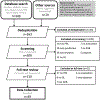Deep representation learning of patient data from Electronic Health Records (EHR): A systematic review
- PMID: 33387683
- PMCID: PMC11290708
- DOI: 10.1016/j.jbi.2020.103671
Deep representation learning of patient data from Electronic Health Records (EHR): A systematic review
Abstract
Objectives: Patient representation learning refers to learning a dense mathematical representation of a patient that encodes meaningful information from Electronic Health Records (EHRs). This is generally performed using advanced deep learning methods. This study presents a systematic review of this field and provides both qualitative and quantitative analyses from a methodological perspective.
Methods: We identified studies developing patient representations from EHRs with deep learning methods from MEDLINE, EMBASE, Scopus, the Association for Computing Machinery (ACM) Digital Library, and the Institute of Electrical and Electronics Engineers (IEEE) Xplore Digital Library. After screening 363 articles, 49 papers were included for a comprehensive data collection.
Results: Publications developing patient representations almost doubled each year from 2015 until 2019. We noticed a typical workflow starting with feeding raw data, applying deep learning models, and ending with clinical outcome predictions as evaluations of the learned representations. Specifically, learning representations from structured EHR data was dominant (37 out of 49 studies). Recurrent Neural Networks were widely applied as the deep learning architecture (Long short-term memory: 13 studies, Gated recurrent unit: 11 studies). Learning was mainly performed in a supervised manner (30 studies) optimized with cross-entropy loss. Disease prediction was the most common application and evaluation (31 studies). Benchmark datasets were mostly unavailable (28 studies) due to privacy concerns of EHR data, and code availability was assured in 20 studies.
Discussion & conclusion: The existing predictive models mainly focus on the prediction of single diseases, rather than considering the complex mechanisms of patients from a holistic review. We show the importance and feasibility of learning comprehensive representations of patient EHR data through a systematic review. Advances in patient representation learning techniques will be essential for powering patient-level EHR analyses. Future work will still be devoted to leveraging the richness and potential of available EHR data. Reproducibility and transparency of reported results will hopefully improve. Knowledge distillation and advanced learning techniques will be exploited to assist the capability of learning patient representation further.
Keywords: Deep learning; Electronic health records; Patient representation; Systematic review.
Copyright © 2020. Published by Elsevier Inc.
Conflict of interest statement
Declaration of Competing Interest
The authors declare that they have no known competing financial interests or personal relationships that could have appeared to influence the work reported in this paper.
Figures




Similar articles
-
Opportunities and challenges in developing deep learning models using electronic health records data: a systematic review.J Am Med Inform Assoc. 2018 Oct 1;25(10):1419-1428. doi: 10.1093/jamia/ocy068. J Am Med Inform Assoc. 2018. PMID: 29893864 Free PMC article.
-
Graph neural networks for clinical risk prediction based on electronic health records: A survey.J Biomed Inform. 2024 Mar;151:104616. doi: 10.1016/j.jbi.2024.104616. Epub 2024 Feb 27. J Biomed Inform. 2024. PMID: 38423267 Review.
-
Question Answering for Electronic Health Records: Scoping Review of Datasets and Models.J Med Internet Res. 2024 Oct 30;26:e53636. doi: 10.2196/53636. J Med Internet Res. 2024. PMID: 39475821 Free PMC article.
-
Applying interpretable deep learning models to identify chronic cough patients using EHR data.Comput Methods Programs Biomed. 2021 Oct;210:106395. doi: 10.1016/j.cmpb.2021.106395. Epub 2021 Sep 4. Comput Methods Programs Biomed. 2021. PMID: 34525412
-
Deep EHR: A Survey of Recent Advances in Deep Learning Techniques for Electronic Health Record (EHR) Analysis.IEEE J Biomed Health Inform. 2018 Sep;22(5):1589-1604. doi: 10.1109/JBHI.2017.2767063. Epub 2017 Oct 27. IEEE J Biomed Health Inform. 2018. PMID: 29989977 Free PMC article. Review.
Cited by
-
LATTE: Label-efficient incident phenotyping from longitudinal electronic health records.Patterns (N Y). 2023 Dec 27;5(1):100906. doi: 10.1016/j.patter.2023.100906. eCollection 2024 Jan 12. Patterns (N Y). 2023. PMID: 38264714 Free PMC article.
-
Predicting Risk of Mortality in Pediatric ICU Based on Ensemble Step-Wise Feature Selection.Health Data Sci. 2021 May 31;2021:9365125. doi: 10.34133/2021/9365125. eCollection 2021. Health Data Sci. 2021. PMID: 38487508 Free PMC article.
-
Self-Supervised Learning-Based General Laboratory Progress Pretrained Model for Cardiovascular Event Detection.IEEE J Transl Eng Health Med. 2023 Aug 23;12:43-55. doi: 10.1109/JTEHM.2023.3307794. eCollection 2024. IEEE J Transl Eng Health Med. 2023. PMID: 38059127 Free PMC article.
-
Predicting neurodevelopmental disorders using machine learning models and electronic health records - status of the field.J Neurodev Disord. 2024 Nov 15;16(1):63. doi: 10.1186/s11689-024-09579-0. J Neurodev Disord. 2024. PMID: 39548397 Free PMC article. Review.
-
Enhancing Patient Outcome Prediction Through Deep Learning With Sequential Diagnosis Codes From Structured Electronic Health Record Data: Systematic Review.J Med Internet Res. 2025 Mar 18;27:e57358. doi: 10.2196/57358. J Med Internet Res. 2025. PMID: 40100249 Free PMC article.
References
-
- Svozil D, Kvasnicka V, Pospichal J, Introduction to multi-layer feed-forward neural networks, Chemomet. Intell. Lab. Syst 39 (1997) 43–62, 10.1016/S0169-7439(97)00061-0. - DOI
-
- Che Z, Kale D, Li W, Bahadori MT, Liu Y, Deep computational phenotyping, in: Proceedings of the 21th ACM SIGKDD International Conference on Knowledge Discovery and Data Mining, ACM, 2015, pp. 507–516.
Publication types
MeSH terms
Grants and funding
LinkOut - more resources
Full Text Sources
Other Literature Sources

